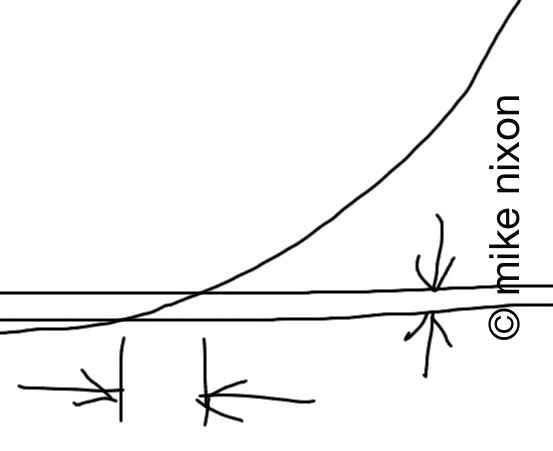|

|
|
Mechanics have known for nearly a hundred years that loose valve clearances are better than tight ones. It's only the inexperienced and those outside the industry who doubt it.
|
There is some debate on user forums about the value of setting motorcycle valve clearances to a spec at the ends of their factory-recommended ranges. As a lifetime tech, the fact that this is even questioned surprises me. It is well known among career motorcycle mechanics that targetting the large end of the valve adjustment range is always a good thing, never a bad one, and in a few special cases, even critical. Two reasons come readily to mind, valve recession and valve seat drift.
Valve recession
This is the biggest problem in Honda's made since the early to mid 1970s. It is in fact endemic. Valve recession is simply the valve gradually, over time, sinking into its seat, due to wear of the valve (mostly) and the seat. Valve recession results in a gradual loss of valve seal because the receding valve's face takes a stepped shape onto its originally very flat "face". Though Kawasaki had similar problems, Honda's 70s engines are over-represented in valve recession, with their plated, soft-metal valve construction and subsequently faster valve wear. Also, probably due to how their vehicles are used, that is, with a lot more of their time spent at higher rpm, air-cooled singles and twins of every stripe are at especially high risk for accelerated valve recession, with a rather more rapid than usual observable recession pattern in such engines. From Honda 90s to 1200s. But all engines recede their valves, even liquid-cooled, multicylinder, moderately-loaded ones. Valve recession is in fact the most ubiquitous valve wear condition one finds during an engine rebuild. It's the normal valve wear pattern. But while valve recession may be considered normal, in many cases it is very rapid. By less than 8,000 miles a vintage Honda shows it in lowered cylinder compression and by 20,000 the compression may be two-thirds its normal value.
Looser valve clearances
Obviously, valve recession is correctable and a proper valve job is how. But setting the valve clearances to the ends of their range or even a bit beyond is a very effective stop-gap. But it is simply a workaround, not a fix. It compensates to an extent for the bad valve seal by mathematically increasing cylinder compression time (in crankshaft degrees) without appreciably affecting anything else valve or cam related. For every 0.001" clearance over the nominal 0.003" factory specification for DOHC fours and CBXs, for example, you stand to gain 10 psi cranking pressure. It's as close to a free lunch as you're going to get. Even better than free, because it actually works.
The effect on valve timing

|
|
As this graph illustrates, a few thousandths of an inch increase in valve clearance creates two changes. The total valve lift, of course, and also the valve timing, that is, when the valve opens. But note which is affected more, the timing. By quite a lot. Whereas the lift is changed by only those few thou, negligible by anyone's standard, the timing on the other hand is altered by several crankshaft degrees, a very significant amount. And therein lies its effectiveness. And a refutation of typical ignorant forum verbal brawling.
|
Some forum members have protested that loosening the valve clearances in this way reduces performance through reduced valve opening distance. As pointed out graphically above, it's obvious this isn't so. Two to three thousandths lift valve reduction has absolutely no effect on tuning, representing as it does less than one-tenth a percent of the total valve opening. The 5 degrees or more of extra cylinder compression however is significant. It's a matter of geometry.
Summation
I have studied and practiced this subject for a long time and I have proven the concepts. But really, I hardly had to. One doesn't have to be a mathematician (and I am not that). Reasonably diligent observation shows that loosening valve clearances is immediately and dramatically beneficial to many different kinds of engines, but particularly certain models and types of engines that inherently suffer from valve sealing issues--like these vintage Hondas--of which there are plenty in powersports. And this with absolutely no drawbacks.
Cam Contemplations #1
Cam Contemplations #2
Cam Contemplations #3
Cam Contemplations #4
Cam Contemplations #5
|

 ®
®

